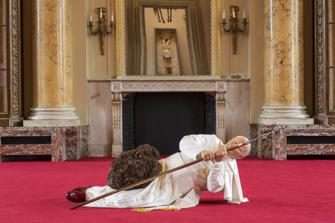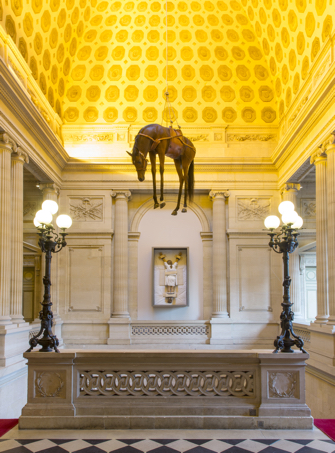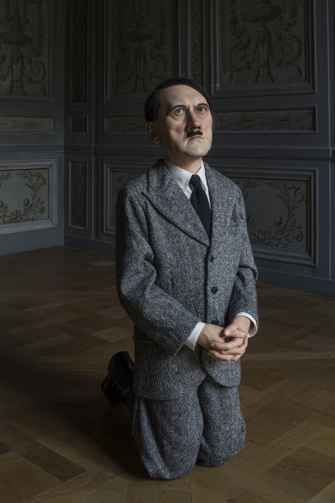
In 2011, at the age of 51, the artist Maurizio Cattelan announced he was giving up his art career, an event marked by a major retrospective (or “artistic suicide,” as some termed it) at the Guggenheim Museum in New York. Was it a gimmick on the part of an attention-grabbing artist? I don’t know, but now he’s back, installing a functional 18-karat-gold toilet in a restroom at the Guggenheim and exhibiting at the Monnaie de Paris in a one-man show, “Maurizio Cattelan: Not Afraid of Love,” which he himself referred to as a “post requiem.”
As if to prove that Cattelan is a thought-provoking artist (he is, and also chuckle-inducing) who should be taken seriously, this exhibition is festooned with texts about his work by an odd collection of commentators: photographers, curators, journalists, singers, dancers, composers, chef Guy Savoy, fashion designer Christian Lacroix, a priest (who is attached to the Beaux Arts de Paris – who knew?), a rabbi and even the current French and Italian ministers of culture.
These texts, most of them long, are presented in French and English but are nearly unreadable, printed as they are in minuscule type, sometimes taped up behind glass. Only one person at a time can read them, which often means long waits, and they are not available online to read later. I really wish museums would stop disrespecting their visitors like this (the Bernard Buffet exhibition at the Musée d’Art Moderne is a refreshing exception to the illegible label rule).
Back to the show. The grand 18th-century apartments of the Monnaie are a wonderful place for Cattelan’s installations, with only one or two in each room, variously decorated with crystal chandeliers, fireplaces, parquet floors and rich ornamentation. Some exhibits are so discreetly placed that it would be easy to miss them, while others have a shock effect that I don’t want to spoil by describing them.
Several, however, are so well known that there is no danger of giving anything away, notably “Novecento” (1997), the taxidermied horse dramatically suspended from the ceiling in the

grand staircase, and “La Nona Ora” (“The Ninth Hour,” 1999), the realistic sculpture of Pope John Paul II struck to the ground by a meteorite. In life, as Dominican Brother Olivier Thomas Venard notes in the accompanying text, the ailing pope leaned on his cross as a literal crutch to steady himself, but it was unable to protect him from the debris from outer space sent by the artist.
The friar writes: “‘Thou art Peter, and upon this rock I will build my church,’ says Christ to his vicar in the Gospel (Matthew 16:18)… ‘And with a rock I shall destroy it,’ the artist seems to make him say. At least one thing is certain: social hierarchies, so necessary in the world in which we live, will one day disappear, and only the hierarchy of charity will remain. And on that day, Karol Wojtyla will be there standing on his own two feet.”
That is one point of view. I prefer to read the sculpture as pure ironical anti-Catholic blasphemy, with the meteorite rock killing off the church built on the rock of St. Peter.
Many of these works will give you a start. And, while some are one-liners, others will make you stand there and reflect as their meaning

resonates and ricochets within you. The texts will offer other interpretations.
I, for one, hope that Cattelan will renounce retirement and continue to make new works. We need his brand of irreverent (literally, in the case of “La Nona Ora”) humor and, yes, blasphemy.
Favorite
